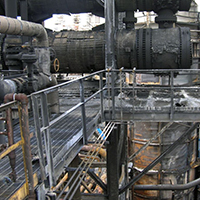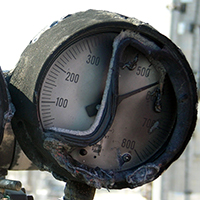Fire Damage Assessment


When a fire occurs on your worksite, the recovery process can be challenging and complex. Stress Engineering Services has supported dozens of Upstream, Midstream, and Downstream operators in the U.S. and throughout North America with fire damage assessments.
Our Approach
Our approach to fire damage assessment is based on the API 579-1/ASME FFS-1 Standard, Fitness-for-Service, and our extensive engineering experience in metallurgy, stress analysis, piping analysis, hardness testing, inspection, heat zone mapping and project management. Our team of professionals establishes heat zones and develops specific inspection plans for each piece of equipment. Ultimately, Level 1, 2, or 3 assessments will determine if the equipment must be repaired, replaced, or can be used as-is. A comprehensive final report documents the findings.
Inspection
Level 1 assessments typically require only visual inspection, but for equipment requiring Level 2 or Level 3 assessment, inspection becomes more involved.
Hardness testing is the most frequently used type of non-destructive examination (NDE) in fire damage assessments. Heat exposure during a fire can either “harden” or “soften” the steel. “Softening” indicates a lower strength, while “hardening” indicates higher strength, less ductility, and increased brittleness in the steel.
Other types of inspections employed may include:
- Visual testing (VT) – including inspection for bowing, sagging, bending, corrosion, cracks, and distortion. VT may include use of our drone services.
- Laser scanning – using our fixed position terrestrial scanner and high-resolution metrology-grade scanner to establish plumb, out of round, distortion, and metal loss.
- Magnetic particle testing (MT) – for surface cracking.
- Eddy current testing (ET) – for surface and near-surface cracking of magnetic materials.
- Ultrasonic testing (UT) – for wall thickness (straight beam) and crack detection (shear wave).
- Acoustic emission testing (AET)– for efficient global inspection focused on cracking.
- Field Metallographic Replication (FMR) – to inspect the material’s surface microstructure without cutting out a sample of metal.
- Videography, High Resolution Photography, and Drone Inspection
Scanning, Videography, and Drone Inspections
We provide both fixed position laser scanning and high-resolution metrology grade laser scanning.
Fixed Position Laser Scanning – 3D laser scanning of vessels and towers for deformation and plumb is performed with our FARO laser scanner. This high-accuracy scanner allows accurate characterization of shape and distortions in large vessels and towers. Because it is offered an in-house service, integration with our finite element analysis is seamless.
Handheld Metrology Grade Laser Scanners – The Creaform high-resolution laser scanner is our instrument-of-choice for high accuracy scanning of smaller features and is used to characterize local deformations and even severe pitting. Once again, because it is offered an in-house service, there is a smooth integration with subsequent analysis.
Drone Photography / Videography and Scanning – Scene documentation and visual inspection is enhanced, and safety increased, with our high-resolution drone inspection capabilities and FAA licensed pilot.
Level 1, 2, And 3 Assessments
Whereas Level 1 fire damage assessment is relatively simple, Level 2 and Level 3 assessments require our expertise and an understanding of materials, mechanics, and plant conditions to ensure the problem is neither over-simplified nor over-analyzed.
Broad Industry Experience
We have performed fire damage assessments in a broad range of oil and gas, petrochemical, gas processing, and chemical plant facilities including numerous petroleum refineries, olefins plants, ethylene plants and other chemical plants, pipeline facilities, above and below-ground storage tanks, onshore and offshore.
Vast Range Of Equipment Types
Fire damage assessments can involve a wide variety of facility processing equipment, structural components, and materials. Our experts have assessed everything from tall towers to condensate drums, including aluminum plate heat exchanges, fin-fan coolers, pumps, compressors, blowers and fans, plant piping, shell and tube heat exchangers, and more.
Structural Steel & Concrete – In general, API 579 addresses only pressure equipment, but industrial fires often involve other components including structural steel and concrete. These very basic components are featured in nearly every fire damage assessment performed by our team of civil/structural engineers who are highly experienced in assessment of these key components.
Full Spectrum Of Services
Fire damage assessment is only one of the services we can offer to support your needs after a fire occurs. Our full spectrum of services includes:
- Origin & Cause Investigation – with Certified Fire Investigators
- Fire Damage Assessment – Fitness-for-Service assessment of fire damaged equipment
- Forensic/Litigation Support – Expert witness support and forensic investigations
Contact us today to learn more about how our fire damage assessment capabilities can help you.



